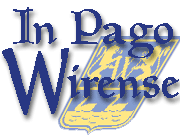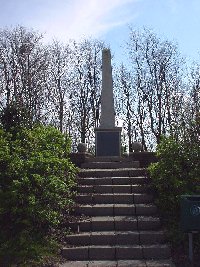

|
| |
 |
the History of Wieringen
As everybody in the Netherlands knows, the 5 years between May 1940 and May 1945 rank among the most traumatic in Dutch history. Even now the liberation from German occupation was more than 50 years ago and there are fewer people that have experienced it personally every year, the second World War is still engraved in the Dutch psyche. Preamble:The history of the Second Worldwar starts in 1939 on Wieringen, when the army is being mobilised because of the war threat. The new Afsluitdijk is of major strategic importance because the enemy could use the Afsluitdijk to threaten the northern part of the Randstad, the Dutch metropolitan area. It was therefore logical that the army leaders decided to defend the dam at any cost. On both the Holland as the Friesland side of the dam large bunkers were built and a large number of soldiers was stationed on and around the dam. Wieringen didn't notice much of the military presence, because especially Hippolytushoef was declared a forbidden area for the soldiers. In those days Hippo' was known as Little Paris, because of all the bars and the "rough" public that came there. The army command didn't want its soldiers being exposed to this "licentiousness". 1940: occupation and adaptionIn May 1940 the German army met unexpected heavy resistance at the Afsluitdijk. They hadn't been able to neutralise the Dutch defences, which is probably one of the reasons for the bombing of Rotterdam on May 14th. After the Dutch surrender a transition period followed in which German rule was established, some uncertain months in which normal life was picked up as best as was possible. It was also a period in which became clear who was on what side. In many places, also on Wieringen, local administration saw no problem whatsoever in collaboration with the occupier. Whether these persons wanted to protect their own interests, thought to be of mor use for their community or seriously believed in the nazi-ideals is something we can't trace back anymore. It is not very interesting for this story anyway. Most people have, certainly in these early days, reacted in a opportunist manner. They wanted to continue with their lifes and behave like nothing had changed. Soon it became clear that wasn't possible. 1941:
Not finished yet! 1942:
On July 13th 1942 the mayor of Wieringen, mr. L.C. Kolff jr. was requested to come to Haarlem for a meeting with the governor for the North-Holland province. When he arrived there he was arrested, along with 9 other mayors from North-Holland. He was taken hostage in the Major Seminary of Haaren (where more prominent Dutch citizens were held hostage, just as in the better-known St. Michielsgestel, which wasn't far from Haaren). Members of the NSB, the Dutch National Socialist Movement, were appointed in their place. 1943:
1943 is mainly the year two English bombers were gunned down over the Waddenzee. All crewmembers died and were buried on the cemetary of Zandburen. 1944:
On December 15th 1944 a large razzia was helt on Wieringen. All men aged between 20 and 40 years had to report for "Arbeitseinsatz", forced labour, in Germany. Because the Germans had sealed off all accessroads, many men couldn't escape. They were ferried to Kampen by boat and from there they went to the factories in Germany. Some of them died in Germany, but most could return safely in May 1945. The hungerwinter:The 1944-1945 winter was very cold, and for a number of reason occupied Netherlands suffered extra. First of all, the allied offensive was stopped at the river Rhine. After the failed operation at Arnhem the allieds had changed their objectives, keeping the northern part of the Netherlands in German hands. Furthermore the railroad workers were on strike. This caused shortages of everything in the big cities. The most critical was the lack of food. In the country plenty of food was available, but there were no means of getting this to the cities. As a consequence many city folk went to get it themselves. Pushing handcarts, on bicycle and even on foot they came to the farmers. The Wieringermeer was a favourite destination, but many went on to Wieringen. Today it's unthinkable, but these people came all the way from Amsterdam or Haarlem for a sack of potatoes or meal. 70 kms over bad roads, with only a bicycle without tyres. When you look at the picture below (click to enlarge it), you'll see what happened when word got out that food could be got somewhere. This photo was taken in March 1945 at my grandfather's farm.
After the war, my grandparents received letters from people who wanted to thank them for the fooddistribution. Most of them didn't, but they probably didn't even know where they had gotten their food. 1945: the end is nearAlthough by 1945 it was just a matter of time before the war ended, the Germans weren't prepared to give up yet. Especially in those final months of the war, many acts of war took place. Most important were the arrest and execution of local resistance fighter Maarten Snoodijk and the inundation of the Wieringermeer. Maarten Snoodijk is Wieringen's best known resistance man. He became famous because he managed to replace the sticks of dynamite underneath the bridge at Van Ewijcksluis with wooden sticks, painted to look like dynamite. Unfortunately he got caught (treason) and was shot by the Germans, only weeks before the end of the war. The Germans had buried him in a manhole along the Short Afsluitdijk, but after the war he was reburied on the cemetary and a monument was placed on his grave. It is a stone bridge, a reminder of his work. A few days before the liberation the Germans blew up the IJsselmeerdijk of the Wieringermeer. The only thinkable reason for this was to inflict as much damage as possible, because a more practical reason why they would want to do this can not be given. The Wieringermeer was under water again, and almost all houses were either damaged or destroyed. Neighbouring places, like Wieringen, had to house a large group of refugees who had lost everything. Only many months later, after the polder had been pumped dry again, these people could go back to where their houses were and rebuilt them. Liberation:
The German commander of Wieringen, nicknamed "the Razor", spent 10 years in the Breda prison, and was released in the 1950s. He was responsible for the killing of Maarten Snoodijk (after the allieds came he had to point out the place where he was buried).  Near Westerland a monument was placed to commemorate all Wieringer people who died in the war.
| ||||||||||||||||||